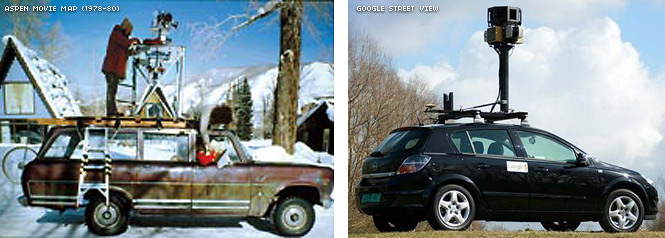Aspen Movie Map was created by Michael Naimark together with Peter Clay and Bob Mohlin the late 1970’s. It was a groundbreaking interactive virtual tour of the real world city of Aspen, Colorado. In this simulated environment, users can navigate the streets, go inside selected buildings, or even change the seasons between fall and winter. After researching, I think that this art work is notable for the two following reasons:
1. an early and classic example of hypermedia system.
2. could be seen as the origin of Google Street View.
Today, when people are wandering through Google Map’s street view, they may never know this idea has existed more than 40 years.
What is hypermedia?
According to “As we may think“, wrote by Vannevar Bush in 1945:
A memex is a device in which an individual stores all his books, records, and communications, and which is mechanized so that it may be consulted with exceeding speed and flexibility. It is an enlarged intimate supplement to his memory.
However, when I deeply found more articles, the term “non-linear” is often used when defining hypertext and hypermedia. I think this term should be done more comparisons and clarification for me and readers.

Simply, novel and encyclopedia can clearly explain what the difference between “linear media” and “non-linear hypermedia” is:
Linear media: the information is written to or read from the medium in a given order, such as novel is intended to be read from beginning to end, and is therefore a linear medium. It may be written in the same way, but would not necessarily need to be, to be considered a linear medium.
Non-linear hypermedia: Non-linear medium is not necessary for the articles to be accessed (or written) in any particular order, like encyclopedia. Linear medium has a set path of how to get from a point to another point, whereas non-linear mediums do not.

 Moreover, I also did a diagram to compare the difference between multimedia and hypermedia. Hypermedia usually refers to “link media” or “interactive media” and could be a software that connects elements(video, plain text or hyperlink) of a computer system, like the following example, Aspen Movie Map.
Moreover, I also did a diagram to compare the difference between multimedia and hypermedia. Hypermedia usually refers to “link media” or “interactive media” and could be a software that connects elements(video, plain text or hyperlink) of a computer system, like the following example, Aspen Movie Map.
The first hypermedia system: Aspen Movie Map

A landmark hypermedia installation which allowed visitors to interactively explore and navigate the roads in a small town in Colorado. It was made through the world’s first laserdisc player which had been intended for the storage and playback of large movies. The below photos showing the automobile rigs used to create panoramas of the streets, then and now. (Aspen Movie Map & Google Street View)

This research what I learned is that, indeed, I never thought Google Street View can represent hypermedia. Users can wander visually the streets through the non-linear but linked medium of information. This is a familiar and classic example for modern people. Additionally, like the first concept of Dyanbook was designed for children, Naimark may never know that his art work can be developed a kind of navigation system for modern people.
